Social Media in Crisis Management: A Comprehensive Literature Review
VerifiedAdded on 2023/04/06
|9
|1438
|387
Literature Review
AI Summary
This literature review examines the role of social media in crisis communication and management, drawing from various peer-reviewed research articles. It covers topics such as the difference between social and information networks, crisis management theories like Rhetorical Arena and multi-vocal approach, the impact of social media on public relations, and the diffusion of crisis-related communication on platforms like Facebook and microblogs. The review also discusses challenges in maintaining networks under uncertainty, the importance of social media in emergency response, and the use of social network analysis in managing construction crises. The included studies explore the dynamics of online communication, gender bias in gaming culture, and the application of social media analytics in organizational public relations, providing a comprehensive overview of the field.
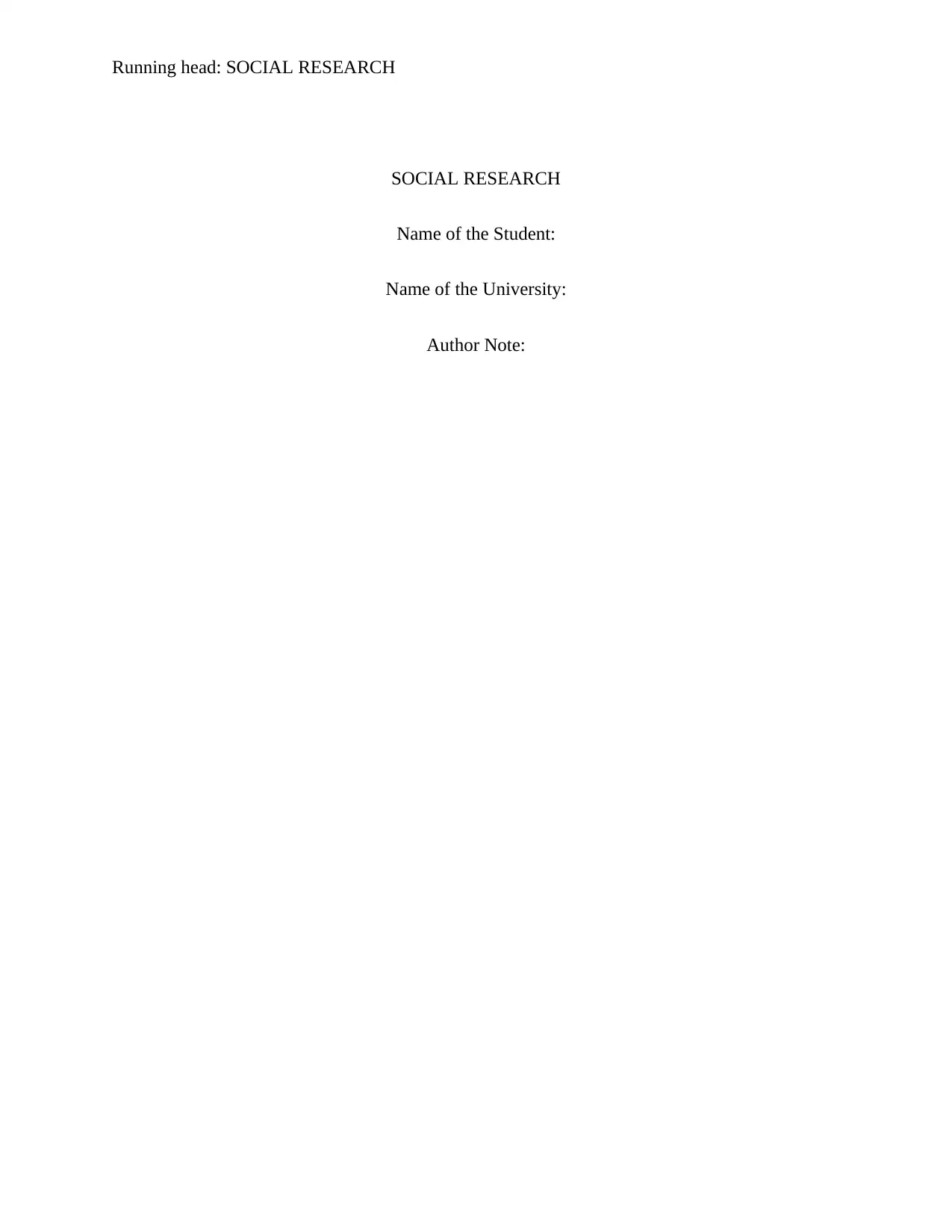
Running head: SOCIAL RESEARCH
SOCIAL RESEARCH
Name of the Student:
Name of the University:
Author Note:
SOCIAL RESEARCH
Name of the Student:
Name of the University:
Author Note:
Paraphrase This Document
Need a fresh take? Get an instant paraphrase of this document with our AI Paraphraser
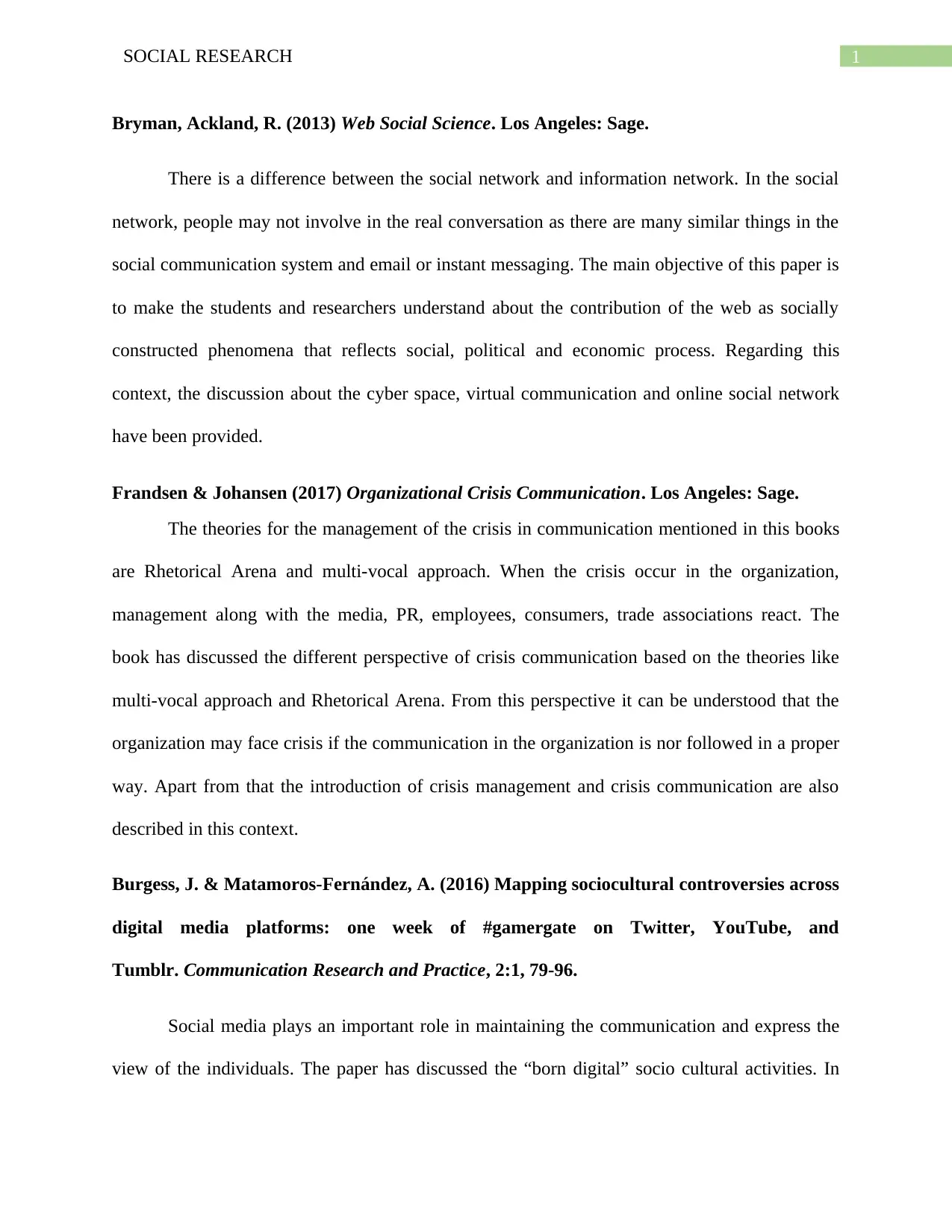
1SOCIAL RESEARCH
Bryman, Ackland, R. (2013) Web Social Science. Los Angeles: Sage.
There is a difference between the social network and information network. In the social
network, people may not involve in the real conversation as there are many similar things in the
social communication system and email or instant messaging. The main objective of this paper is
to make the students and researchers understand about the contribution of the web as socially
constructed phenomena that reflects social, political and economic process. Regarding this
context, the discussion about the cyber space, virtual communication and online social network
have been provided.
Frandsen & Johansen (2017) Organizational Crisis Communication. Los Angeles: Sage.
The theories for the management of the crisis in communication mentioned in this books
are Rhetorical Arena and multi-vocal approach. When the crisis occur in the organization,
management along with the media, PR, employees, consumers, trade associations react. The
book has discussed the different perspective of crisis communication based on the theories like
multi-vocal approach and Rhetorical Arena. From this perspective it can be understood that the
organization may face crisis if the communication in the organization is nor followed in a proper
way. Apart from that the introduction of crisis management and crisis communication are also
described in this context.
Burgess, J. & Matamoros-Fernández, A. (2016) Mapping sociocultural controversies across
digital media platforms: one week of #gamergate on Twitter, YouTube, and
Tumblr. Communication Research and Practice, 2:1, 79-96.
Social media plays an important role in maintaining the communication and express the
view of the individuals. The paper has discussed the “born digital” socio cultural activities. In
Bryman, Ackland, R. (2013) Web Social Science. Los Angeles: Sage.
There is a difference between the social network and information network. In the social
network, people may not involve in the real conversation as there are many similar things in the
social communication system and email or instant messaging. The main objective of this paper is
to make the students and researchers understand about the contribution of the web as socially
constructed phenomena that reflects social, political and economic process. Regarding this
context, the discussion about the cyber space, virtual communication and online social network
have been provided.
Frandsen & Johansen (2017) Organizational Crisis Communication. Los Angeles: Sage.
The theories for the management of the crisis in communication mentioned in this books
are Rhetorical Arena and multi-vocal approach. When the crisis occur in the organization,
management along with the media, PR, employees, consumers, trade associations react. The
book has discussed the different perspective of crisis communication based on the theories like
multi-vocal approach and Rhetorical Arena. From this perspective it can be understood that the
organization may face crisis if the communication in the organization is nor followed in a proper
way. Apart from that the introduction of crisis management and crisis communication are also
described in this context.
Burgess, J. & Matamoros-Fernández, A. (2016) Mapping sociocultural controversies across
digital media platforms: one week of #gamergate on Twitter, YouTube, and
Tumblr. Communication Research and Practice, 2:1, 79-96.
Social media plays an important role in maintaining the communication and express the
view of the individuals. The paper has discussed the “born digital” socio cultural activities. In
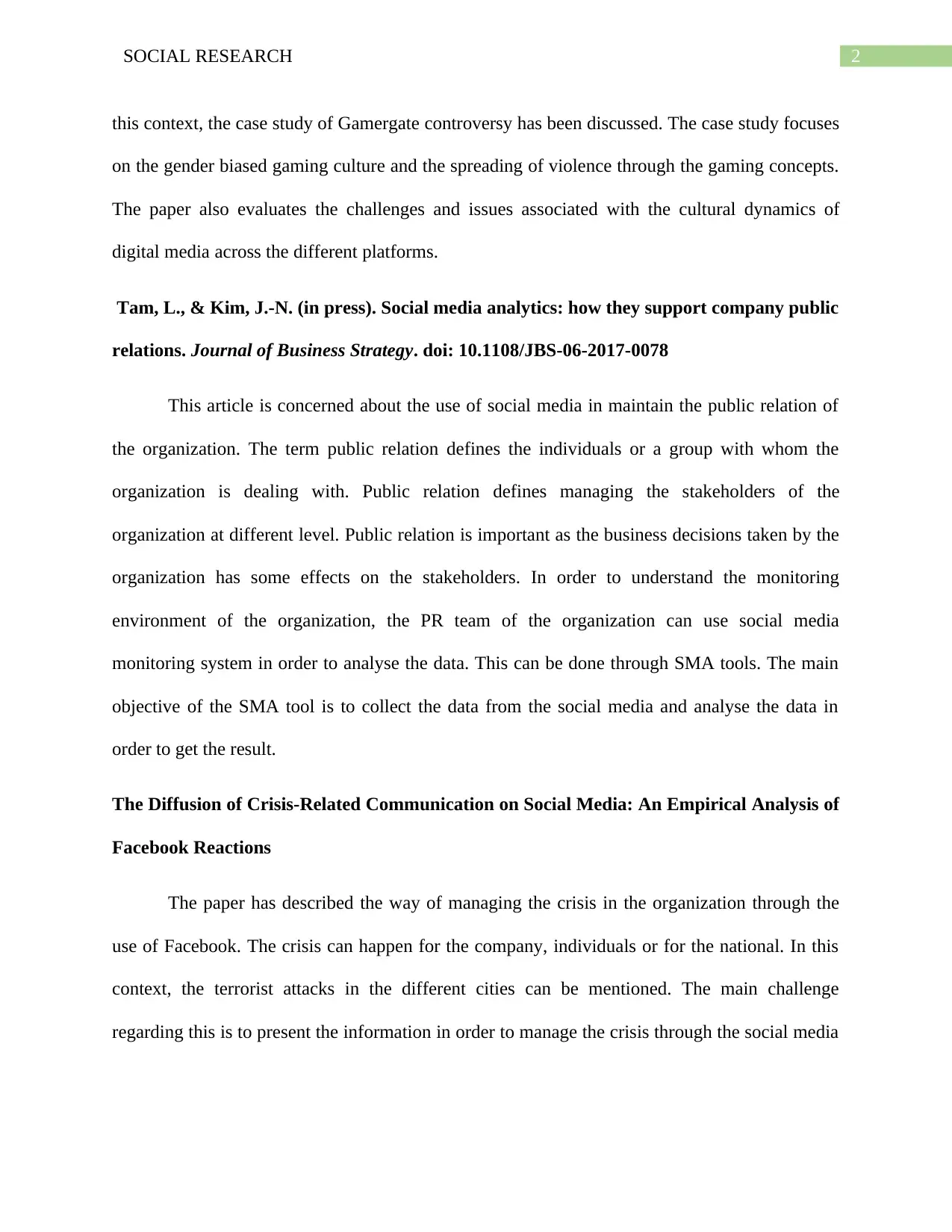
2SOCIAL RESEARCH
this context, the case study of Gamergate controversy has been discussed. The case study focuses
on the gender biased gaming culture and the spreading of violence through the gaming concepts.
The paper also evaluates the challenges and issues associated with the cultural dynamics of
digital media across the different platforms.
Tam, L., & Kim, J.-N. (in press). Social media analytics: how they support company public
relations. Journal of Business Strategy. doi: 10.1108/JBS-06-2017-0078
This article is concerned about the use of social media in maintain the public relation of
the organization. The term public relation defines the individuals or a group with whom the
organization is dealing with. Public relation defines managing the stakeholders of the
organization at different level. Public relation is important as the business decisions taken by the
organization has some effects on the stakeholders. In order to understand the monitoring
environment of the organization, the PR team of the organization can use social media
monitoring system in order to analyse the data. This can be done through SMA tools. The main
objective of the SMA tool is to collect the data from the social media and analyse the data in
order to get the result.
The Diffusion of Crisis-Related Communication on Social Media: An Empirical Analysis of
Facebook Reactions
The paper has described the way of managing the crisis in the organization through the
use of Facebook. The crisis can happen for the company, individuals or for the national. In this
context, the terrorist attacks in the different cities can be mentioned. The main challenge
regarding this is to present the information in order to manage the crisis through the social media
this context, the case study of Gamergate controversy has been discussed. The case study focuses
on the gender biased gaming culture and the spreading of violence through the gaming concepts.
The paper also evaluates the challenges and issues associated with the cultural dynamics of
digital media across the different platforms.
Tam, L., & Kim, J.-N. (in press). Social media analytics: how they support company public
relations. Journal of Business Strategy. doi: 10.1108/JBS-06-2017-0078
This article is concerned about the use of social media in maintain the public relation of
the organization. The term public relation defines the individuals or a group with whom the
organization is dealing with. Public relation defines managing the stakeholders of the
organization at different level. Public relation is important as the business decisions taken by the
organization has some effects on the stakeholders. In order to understand the monitoring
environment of the organization, the PR team of the organization can use social media
monitoring system in order to analyse the data. This can be done through SMA tools. The main
objective of the SMA tool is to collect the data from the social media and analyse the data in
order to get the result.
The Diffusion of Crisis-Related Communication on Social Media: An Empirical Analysis of
Facebook Reactions
The paper has described the way of managing the crisis in the organization through the
use of Facebook. The crisis can happen for the company, individuals or for the national. In this
context, the terrorist attacks in the different cities can be mentioned. The main challenge
regarding this is to present the information in order to manage the crisis through the social media
⊘ This is a preview!⊘
Do you want full access?
Subscribe today to unlock all pages.

Trusted by 1+ million students worldwide
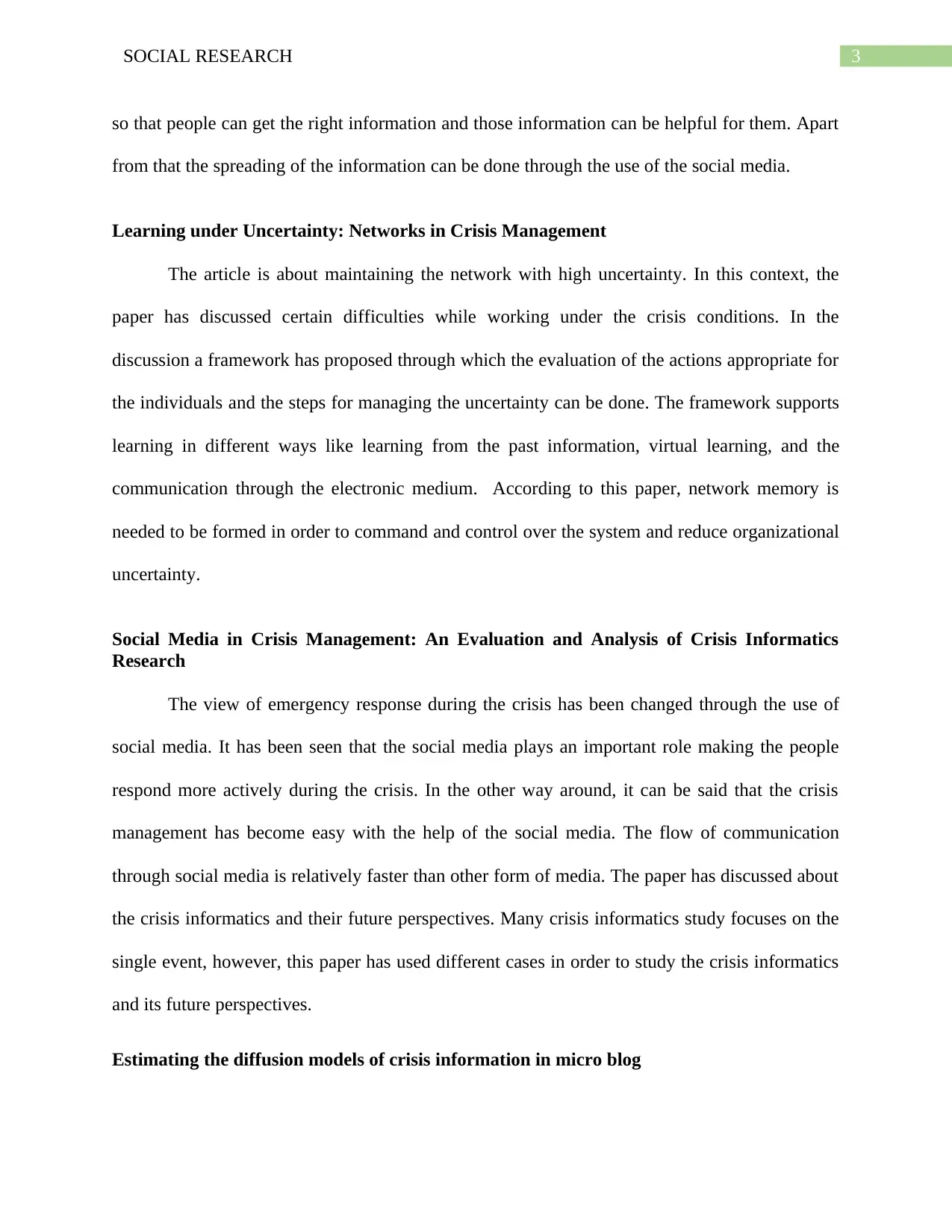
3SOCIAL RESEARCH
so that people can get the right information and those information can be helpful for them. Apart
from that the spreading of the information can be done through the use of the social media.
Learning under Uncertainty: Networks in Crisis Management
The article is about maintaining the network with high uncertainty. In this context, the
paper has discussed certain difficulties while working under the crisis conditions. In the
discussion a framework has proposed through which the evaluation of the actions appropriate for
the individuals and the steps for managing the uncertainty can be done. The framework supports
learning in different ways like learning from the past information, virtual learning, and the
communication through the electronic medium. According to this paper, network memory is
needed to be formed in order to command and control over the system and reduce organizational
uncertainty.
Social Media in Crisis Management: An Evaluation and Analysis of Crisis Informatics
Research
The view of emergency response during the crisis has been changed through the use of
social media. It has been seen that the social media plays an important role making the people
respond more actively during the crisis. In the other way around, it can be said that the crisis
management has become easy with the help of the social media. The flow of communication
through social media is relatively faster than other form of media. The paper has discussed about
the crisis informatics and their future perspectives. Many crisis informatics study focuses on the
single event, however, this paper has used different cases in order to study the crisis informatics
and its future perspectives.
Estimating the diffusion models of crisis information in micro blog
so that people can get the right information and those information can be helpful for them. Apart
from that the spreading of the information can be done through the use of the social media.
Learning under Uncertainty: Networks in Crisis Management
The article is about maintaining the network with high uncertainty. In this context, the
paper has discussed certain difficulties while working under the crisis conditions. In the
discussion a framework has proposed through which the evaluation of the actions appropriate for
the individuals and the steps for managing the uncertainty can be done. The framework supports
learning in different ways like learning from the past information, virtual learning, and the
communication through the electronic medium. According to this paper, network memory is
needed to be formed in order to command and control over the system and reduce organizational
uncertainty.
Social Media in Crisis Management: An Evaluation and Analysis of Crisis Informatics
Research
The view of emergency response during the crisis has been changed through the use of
social media. It has been seen that the social media plays an important role making the people
respond more actively during the crisis. In the other way around, it can be said that the crisis
management has become easy with the help of the social media. The flow of communication
through social media is relatively faster than other form of media. The paper has discussed about
the crisis informatics and their future perspectives. Many crisis informatics study focuses on the
single event, however, this paper has used different cases in order to study the crisis informatics
and its future perspectives.
Estimating the diffusion models of crisis information in micro blog
Paraphrase This Document
Need a fresh take? Get an instant paraphrase of this document with our AI Paraphraser
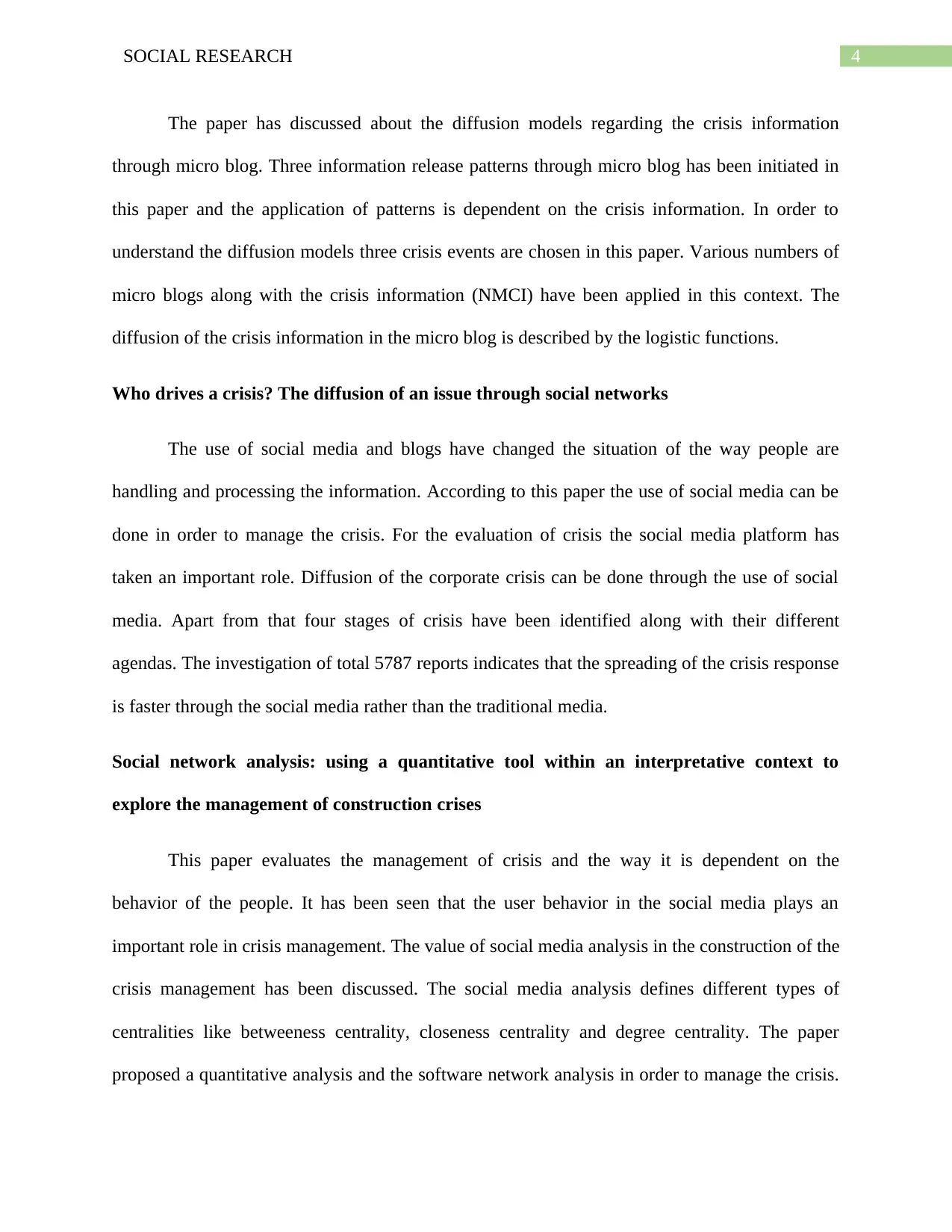
4SOCIAL RESEARCH
The paper has discussed about the diffusion models regarding the crisis information
through micro blog. Three information release patterns through micro blog has been initiated in
this paper and the application of patterns is dependent on the crisis information. In order to
understand the diffusion models three crisis events are chosen in this paper. Various numbers of
micro blogs along with the crisis information (NMCI) have been applied in this context. The
diffusion of the crisis information in the micro blog is described by the logistic functions.
Who drives a crisis? The diffusion of an issue through social networks
The use of social media and blogs have changed the situation of the way people are
handling and processing the information. According to this paper the use of social media can be
done in order to manage the crisis. For the evaluation of crisis the social media platform has
taken an important role. Diffusion of the corporate crisis can be done through the use of social
media. Apart from that four stages of crisis have been identified along with their different
agendas. The investigation of total 5787 reports indicates that the spreading of the crisis response
is faster through the social media rather than the traditional media.
Social network analysis: using a quantitative tool within an interpretative context to
explore the management of construction crises
This paper evaluates the management of crisis and the way it is dependent on the
behavior of the people. It has been seen that the user behavior in the social media plays an
important role in crisis management. The value of social media analysis in the construction of the
crisis management has been discussed. The social media analysis defines different types of
centralities like betweeness centrality, closeness centrality and degree centrality. The paper
proposed a quantitative analysis and the software network analysis in order to manage the crisis.
The paper has discussed about the diffusion models regarding the crisis information
through micro blog. Three information release patterns through micro blog has been initiated in
this paper and the application of patterns is dependent on the crisis information. In order to
understand the diffusion models three crisis events are chosen in this paper. Various numbers of
micro blogs along with the crisis information (NMCI) have been applied in this context. The
diffusion of the crisis information in the micro blog is described by the logistic functions.
Who drives a crisis? The diffusion of an issue through social networks
The use of social media and blogs have changed the situation of the way people are
handling and processing the information. According to this paper the use of social media can be
done in order to manage the crisis. For the evaluation of crisis the social media platform has
taken an important role. Diffusion of the corporate crisis can be done through the use of social
media. Apart from that four stages of crisis have been identified along with their different
agendas. The investigation of total 5787 reports indicates that the spreading of the crisis response
is faster through the social media rather than the traditional media.
Social network analysis: using a quantitative tool within an interpretative context to
explore the management of construction crises
This paper evaluates the management of crisis and the way it is dependent on the
behavior of the people. It has been seen that the user behavior in the social media plays an
important role in crisis management. The value of social media analysis in the construction of the
crisis management has been discussed. The social media analysis defines different types of
centralities like betweeness centrality, closeness centrality and degree centrality. The paper
proposed a quantitative analysis and the software network analysis in order to manage the crisis.
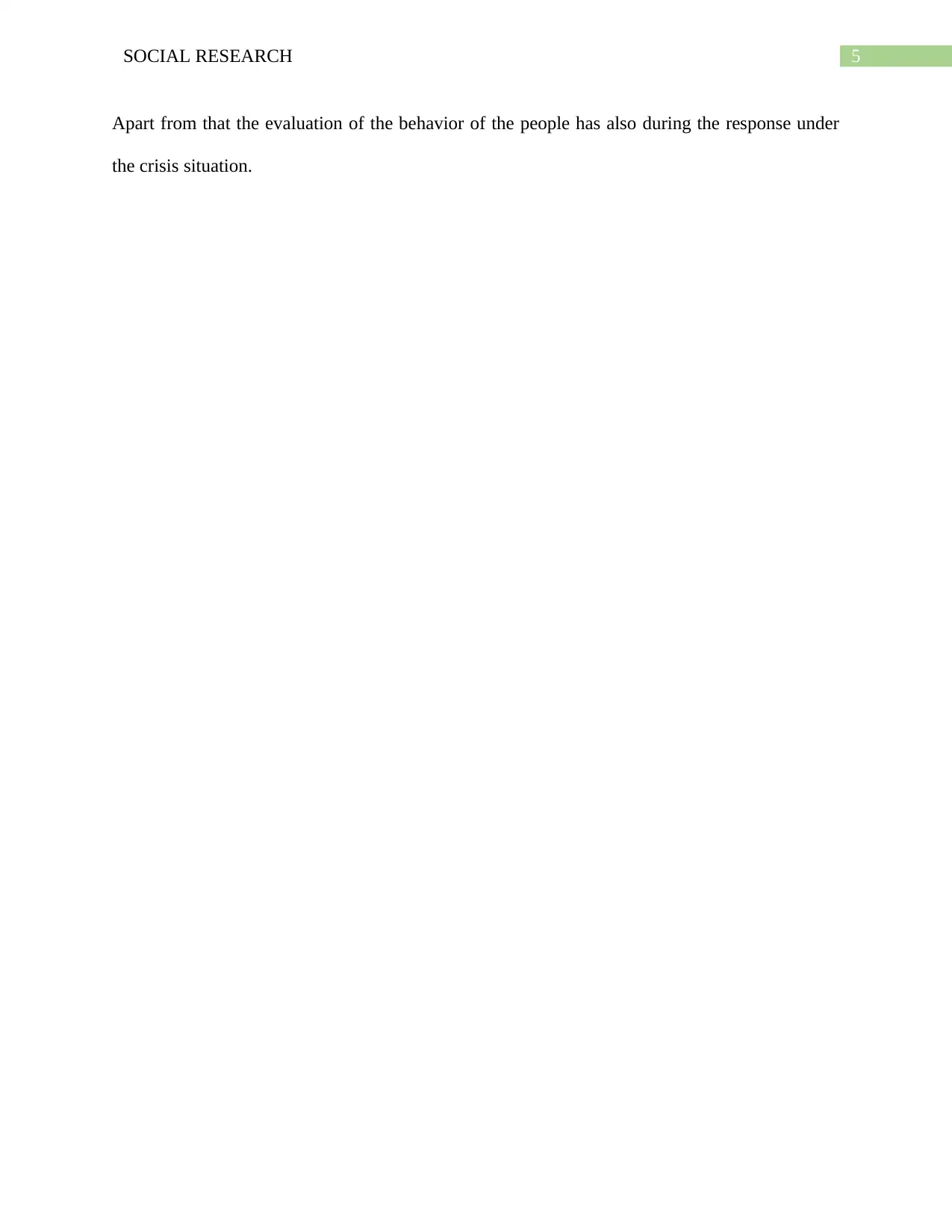
5SOCIAL RESEARCH
Apart from that the evaluation of the behavior of the people has also during the response under
the crisis situation.
Apart from that the evaluation of the behavior of the people has also during the response under
the crisis situation.
⊘ This is a preview!⊘
Do you want full access?
Subscribe today to unlock all pages.

Trusted by 1+ million students worldwide
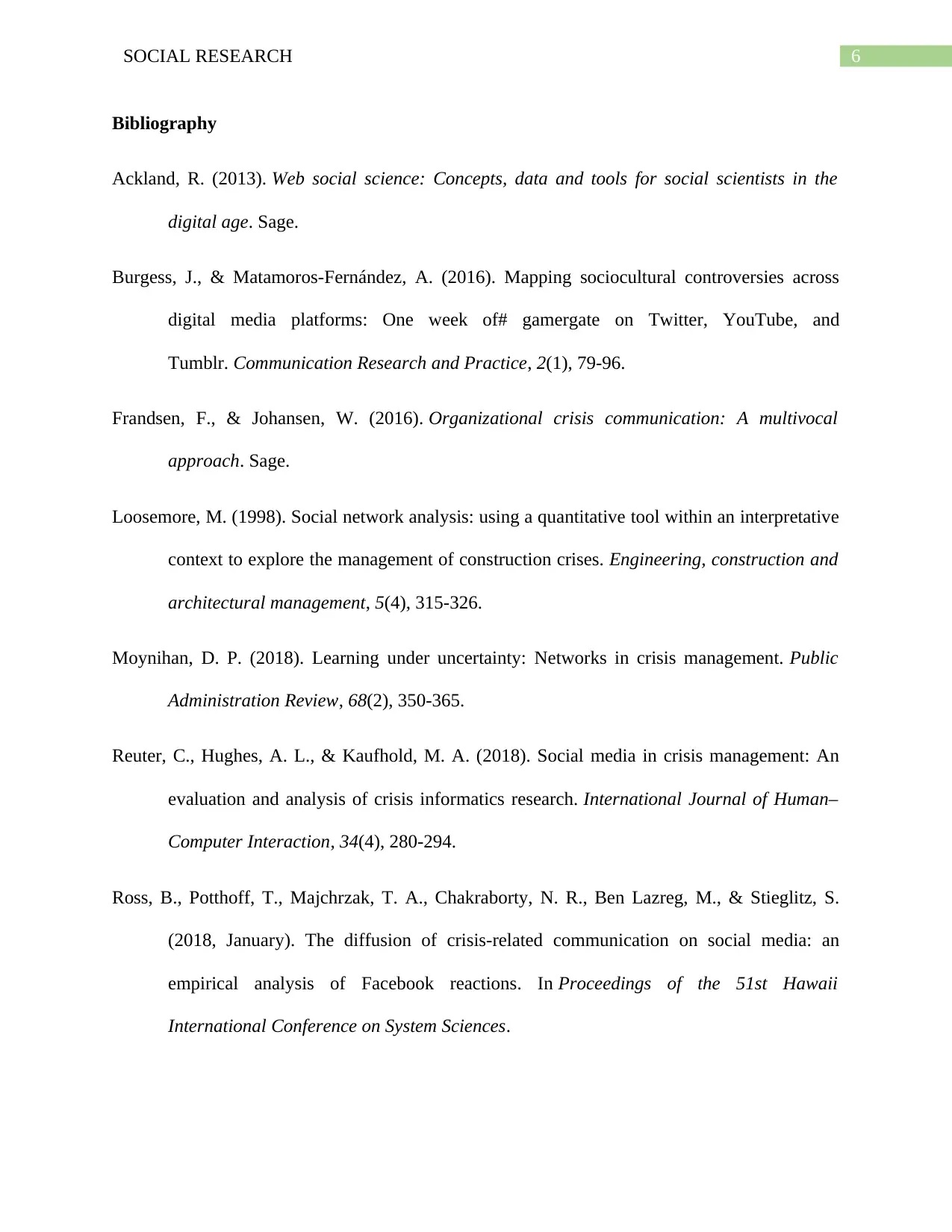
6SOCIAL RESEARCH
Bibliography
Ackland, R. (2013). Web social science: Concepts, data and tools for social scientists in the
digital age. Sage.
Burgess, J., & Matamoros-Fernández, A. (2016). Mapping sociocultural controversies across
digital media platforms: One week of# gamergate on Twitter, YouTube, and
Tumblr. Communication Research and Practice, 2(1), 79-96.
Frandsen, F., & Johansen, W. (2016). Organizational crisis communication: A multivocal
approach. Sage.
Loosemore, M. (1998). Social network analysis: using a quantitative tool within an interpretative
context to explore the management of construction crises. Engineering, construction and
architectural management, 5(4), 315-326.
Moynihan, D. P. (2018). Learning under uncertainty: Networks in crisis management. Public
Administration Review, 68(2), 350-365.
Reuter, C., Hughes, A. L., & Kaufhold, M. A. (2018). Social media in crisis management: An
evaluation and analysis of crisis informatics research. International Journal of Human–
Computer Interaction, 34(4), 280-294.
Ross, B., Potthoff, T., Majchrzak, T. A., Chakraborty, N. R., Ben Lazreg, M., & Stieglitz, S.
(2018, January). The diffusion of crisis-related communication on social media: an
empirical analysis of Facebook reactions. In Proceedings of the 51st Hawaii
International Conference on System Sciences.
Bibliography
Ackland, R. (2013). Web social science: Concepts, data and tools for social scientists in the
digital age. Sage.
Burgess, J., & Matamoros-Fernández, A. (2016). Mapping sociocultural controversies across
digital media platforms: One week of# gamergate on Twitter, YouTube, and
Tumblr. Communication Research and Practice, 2(1), 79-96.
Frandsen, F., & Johansen, W. (2016). Organizational crisis communication: A multivocal
approach. Sage.
Loosemore, M. (1998). Social network analysis: using a quantitative tool within an interpretative
context to explore the management of construction crises. Engineering, construction and
architectural management, 5(4), 315-326.
Moynihan, D. P. (2018). Learning under uncertainty: Networks in crisis management. Public
Administration Review, 68(2), 350-365.
Reuter, C., Hughes, A. L., & Kaufhold, M. A. (2018). Social media in crisis management: An
evaluation and analysis of crisis informatics research. International Journal of Human–
Computer Interaction, 34(4), 280-294.
Ross, B., Potthoff, T., Majchrzak, T. A., Chakraborty, N. R., Ben Lazreg, M., & Stieglitz, S.
(2018, January). The diffusion of crisis-related communication on social media: an
empirical analysis of Facebook reactions. In Proceedings of the 51st Hawaii
International Conference on System Sciences.
Paraphrase This Document
Need a fresh take? Get an instant paraphrase of this document with our AI Paraphraser
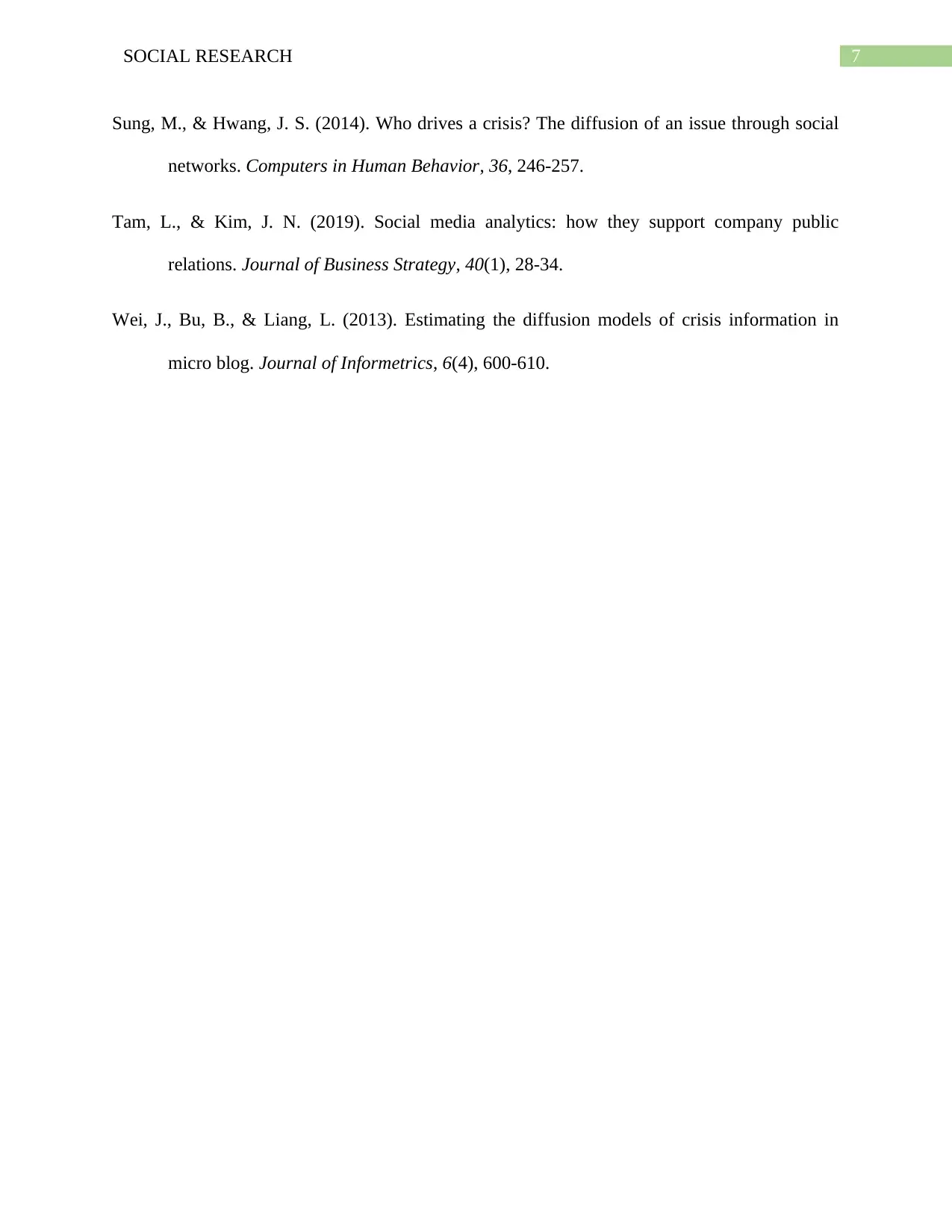
7SOCIAL RESEARCH
Sung, M., & Hwang, J. S. (2014). Who drives a crisis? The diffusion of an issue through social
networks. Computers in Human Behavior, 36, 246-257.
Tam, L., & Kim, J. N. (2019). Social media analytics: how they support company public
relations. Journal of Business Strategy, 40(1), 28-34.
Wei, J., Bu, B., & Liang, L. (2013). Estimating the diffusion models of crisis information in
micro blog. Journal of Informetrics, 6(4), 600-610.
Sung, M., & Hwang, J. S. (2014). Who drives a crisis? The diffusion of an issue through social
networks. Computers in Human Behavior, 36, 246-257.
Tam, L., & Kim, J. N. (2019). Social media analytics: how they support company public
relations. Journal of Business Strategy, 40(1), 28-34.
Wei, J., Bu, B., & Liang, L. (2013). Estimating the diffusion models of crisis information in
micro blog. Journal of Informetrics, 6(4), 600-610.

8SOCIAL RESEARCH
⊘ This is a preview!⊘
Do you want full access?
Subscribe today to unlock all pages.

Trusted by 1+ million students worldwide
1 out of 9
Your All-in-One AI-Powered Toolkit for Academic Success.
+13062052269
info@desklib.com
Available 24*7 on WhatsApp / Email
![[object Object]](/_next/static/media/star-bottom.7253800d.svg)
Unlock your academic potential
Copyright © 2020–2025 A2Z Services. All Rights Reserved. Developed and managed by ZUCOL.
